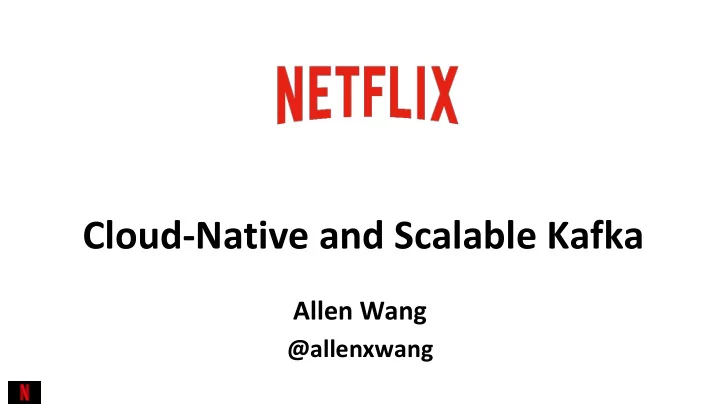

Cloud-Native and Scalable Kafka Allen Wang @allenxwang
About Me ● Real Time Data Infrastructure @ Netflix ● Apache Kafka contributor (KIP-36 Rack Aware Assignment) ● NetflixOSS contributor (Archaius and Ribbon) ● Previously ○ Cloud platform @ Netflix ○ VeriSign, Sun Microsystems
About Me ● Real Time Data Infrastructure @ Netflix ● Apache Kafka contributor (KIP-36 Rack Aware Assignment) ● NetflixOSS contributor (Archaius and Ribbon) ● Previously ○ Cloud platform @ Netflix ○ VeriSign, Sun Microsystems
They All Come To One Place Source: http://kafka.apache.org
What’s In the Talk
Kafka - Distributed Streaming Platform Source: http://kafka.apache.org
Kafka @ Netflix ● Data Pipeline and stream processing ○ Business and analytical data ○ System related ● Huge volume but non-transactional data ● Order is not required for most of topics
Kafka @ Netflix Scale ● 4,000+ brokers and ~50 clusters in 3 AWS regions ● > 1 Trillion messages per day ● At peak (New Years Day 2018) ○ 2.2 trillion messages (1.3 trillion unique) ○ 6 Petabytes
A Typical Netflix Kafka Cluster ● 20 to 200 brokers ● 4 to 8 cores, Gbps network, 2 to 12 TB local disk ● Brokers on Kafka 0.10.2 ● Span across three availability zones within a region with rack aware assignment ● MirrorMaker for cross region replication for selected topics
Challenges
Availability
Availability Defined ● Ratio of messages successfully produced to Kafka vs. total attempts
Availability Challenge
Availability Challenge ● We have improved ○ Over 99.999% availability ● Failover is must to have
Scalability
Scalability Challenge
Desired Autoscale
Why Scaling is Difficult ● Add brokers and partitions ○ Currently does not work well with keyed messages ○ Practical limit of number of partitions ○ Watch for KIP-253: In order message delivery with partition expansion and deletion ● Partition reassignment ○ Data copying is time consuming ○ Increased network traffic
Think Out Of the Box
Scale with Traffic Producer Cluster 1 Consumer Cluster 2
Topic Move/Failover Cluster 1 Producer Consumer Cluster 2
Failover with Traffic Migration ● Netflix operates in island model ● In region Kafka failover ○ Failover by switching client traffic to a different cluster ○ No extra cost for redundancy or cross DC traffic ○ No ordering guarantee ○ Best case: exactly once ○ Worst case: data loss
Better Scalability with Multi-Cluster ● No data copying! ● Built-in failover capability ● Requires built-in client support to switch traffic ○ Currently implemented with client dynamic properties ● Does not work with keyed messages - still WIP
Improvement on Availability Cluster 1 Cluster 2 Cluster 3
Let’s Prove It ● Divide one big cluster into s clusters ● Assumptions ○ Replication factor k in both cases ○ losing k brokers always lead to unavailability ● Small clusters can be s k-1 times more reliable than one big cluster
The Math Compare number of combinations to choose k brokers from a cluster of size n vs. from any one of s clusters of size m
Challenge From High Data Fan-Out
Scaling with Cluster Chaining
The Ideas of Multi-Cluster ● Break up big clusters into small clusters ○ Mostly immutable ○ Scale by adding/removing clusters ○ Improve availability by failover with client traffic migration ● Connect clusters with routing services for high data fan-out ● Management service for automation and orchestration
Pets To Cattle
Multi-Cluster Kafka Service At Netflix Management HTTP PROXY Router (w/ simple ETL) Consumers Event Fronting Consumer Producer Kafka Kafka
Multi-Tenancy
Multi-Tenancy At Scale ● Cluster with the largest number of clients ○ Number of microservices accessing the cluster: 400+ ○ Average number of network connections per broker at peak: 33,000+
The Goal ● Know your clients ● Ensure fair share of resources ● Better capacity planning
Client Registration Authentication ACL and quota
Multi-Tenancy ● Identify your consumer - the old ways ○ Email, Slack … ○ Code search ○ TCPdump
Identity with Security ● Integrate with Netflix security system ○ Utilize standard Netflix client certs on every instance ○ Utilize Netflix authorization service to define policies ○ Map Kafka operations to HTTP methods ● Result - ACL and quota based on true application identity
Auth Permission for “X” for Service Write Topic operation “ PUT /Topic/Foo” ? App “X” “Foo” Ack Allowed
Takeaways ● Improve scalability and availability with multiple clusters ○ Scale with traffic by adding/removing clusters ○ Failover by migrating client traffic ○ Chain clusters to provide better solution for data fan-out ● Integrate with SSL infrastructure and your own auth service to lay the foundation of multi-tenancy management
Thank You
Recommend
More recommend